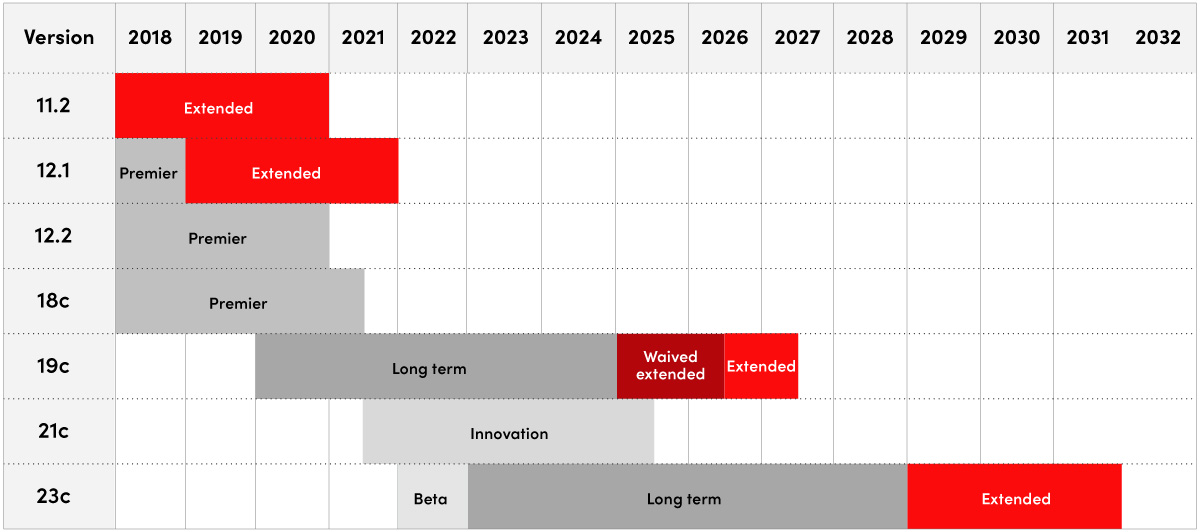Oracle Database 19c upgrades

Frequently Asked Questions
By Geordie Coates
Director of DBA Services at Inoapps
With all versions older than Oracle Database 19c now out of support, there’s no denying that if you aren’t already on 19c, it’s time to upgrade. And fast. Any upgrade is a big decision, and you likely have questions about the project. We’ve outlined some we’re asked most often, along with what your upgrade would look like.
Common questions on Oracle Database 19c upgrades
1. Why should I upgrade to 19c?
The most obvious answer is to maintain Oracle support without the additional expense. Upgrading to 19c will ensure that your organization continues to receive premier support without having to pay any extended support fees. Here’s the oracle support timeline:

Additionally, older Oracle database versions aren’t certified or supported on the newer operating systems, so your database may have been restricting you from updating your operating system and/or hardware. If that’s the case for you, this is a great opportunity to improve your infrastructure as well. This upgrade will also keep you current on all security updates.
Finally, Oracle development’s biggest focus for 19c was fixing known issues. Rather than simply adding new functionality, Oracle was heavily focused on adding stability to 19c, which included extensive testing, thousands of bug fixes, and analyzing all aspects of performance and functionality to guarantee a stable environment that can stay supported for a longer period of time.
2. What changes should I expect in 19c?
While this may seem like a straightforward upgrade, there are a few changes that users can expect to see after upgrading to 19c:
- Mandatory multi-tenant configuration: multi-tenant architecture was released in 12c, but EBS didn’t have to adopt it at that point—now there’s no longer a choice. It’s a requirement to have EBS as a pluggable database with 19c in a multi-tenant configuration.
- UTL_FILE_DIR is no longer supported: You’ll now have to specify the name of a directory object instead of using the UTL_FILE_DIR Initialization Parameter.
- Potential architecture/platform changes: Keep an eye on your architecture and platforms. As I mentioned earlier, if you’re sitting on older hardware or operating system, now is the right time to consider a refresh, as you will likely need to be on newer versions to support 19c. Most of our clients undertaking upgrades had to accommodate new hardware or software updates, so it’s important that this taken into consideration.
- New features: Again, Oracle’s focus was heavily guided towards maintaining stability and supportability for the long-term, so you’re supported until 2027 with Extended Support.
3. What are the upgrade paths to 19c?
For anyone currently on 11.2.0.4, 12.1.0.2, 12.2.0.1 or 18c (12.2.0.2), there is a direct path to upgrade to 19c (12.2.0.3). Older versions have a couple of options to get to 19c. The first would be to upgrade to one of the versions listed, which would then give you a direct path to 19c. Another option for consideration, especially if you’re doing a platform change, is to move straight from your source into a 19c target and go directly into the upgrade.
4. What does a typical 19c upgrade look like?
The following is a high-level overview of the upgrade process:
- Verify your environment
You’ll need to verify your environment and document everything. Make sure your platform configurations are certified, run some health checks, verify your software versions are at the right levels, read all of the available collateral, and document the entire process. - 19c Database installation
Here’s where you’ll kick it off. You’ll install the 19.3 and latest 19.8 release updates in a new Oracle Home and create the CDB (Container Database). - Upgrade your database to 19c
Perform the required additional steps and run the database upgrade assistant to upgrade your database. - Post-upgrade database steps
Execute all the post-upgrade administrative tasks. - Create your EBS pluggable database
Create your multi-tenant environment; convert your non-container database (your EBS environment) to a pluggable database (PDB). - Update initialization parameters
Update the initialization parameters needed for 19c - Autoconfig and start EBS
Run autoconfig and start up your EBS application to complete the upgrade process.
Afterwards, you’ll want to update all your documentation for all the steps you’ve just completed and then do it all again.
If you need to upgrade to 19c, our team is here to help. But don’t just take our word for it. We’ve performed numerous 19c upgrades over the last few years, and here’s what our customers have to say:
“The Inoapps team was able to structure scope of work clearly. Met all the targets provided, and issues were addressed by the team immediately. Satisfied with 19c upgrade.”
Marvin Hood
Chief Information Officer at WIHCC
“I wanted to personally thank Inoapps for a very successful Oracle EBS 12.2 and Oracle Database 19c upgrade that occurred over the holidays for New year. You and your team have been a tremendous partner with us through this journey and the commitment and dedication you exhibited with our internal teams has been fantastic. Apologies for the long nights of work over the holidays and working around our plant shutdown windows but it is very much appreciated.”
Glenn Griffin
Chief Information Officer at Bradford White
While I’ve covered some of the more common questions, we’ve encountered about upgrading to 19c, we know that you likely have your own. Please don’t hesitate to get in contact on askinoapps@inoapps.com if you’d like to chat about how we can help.
